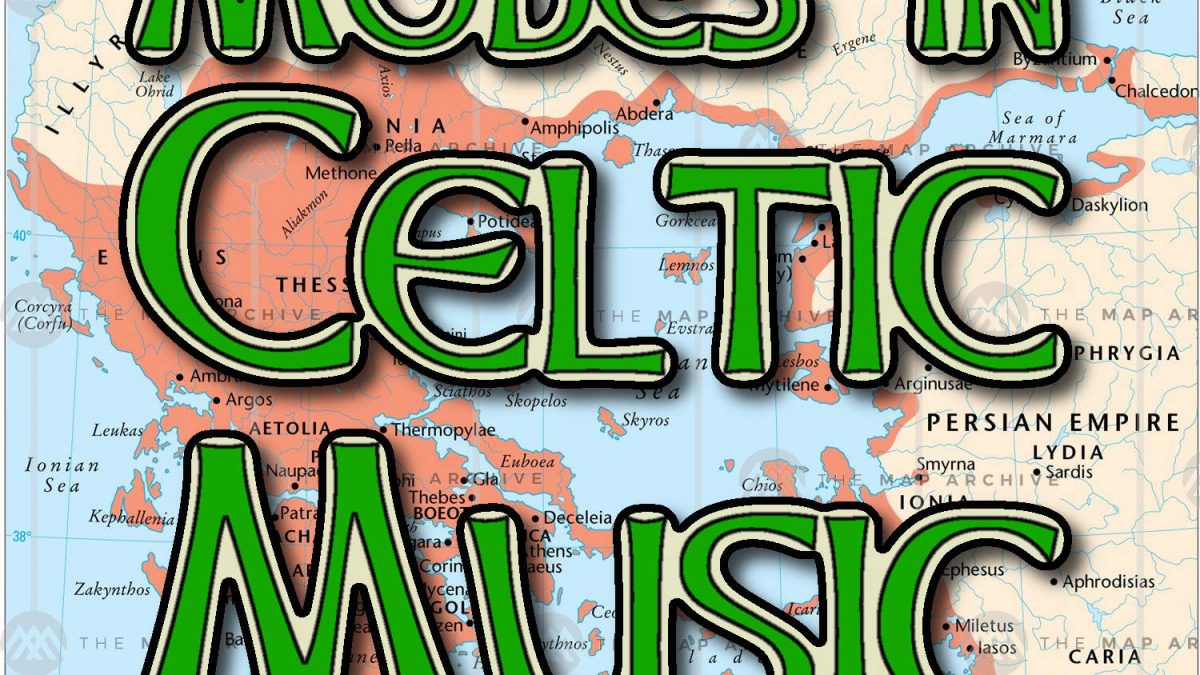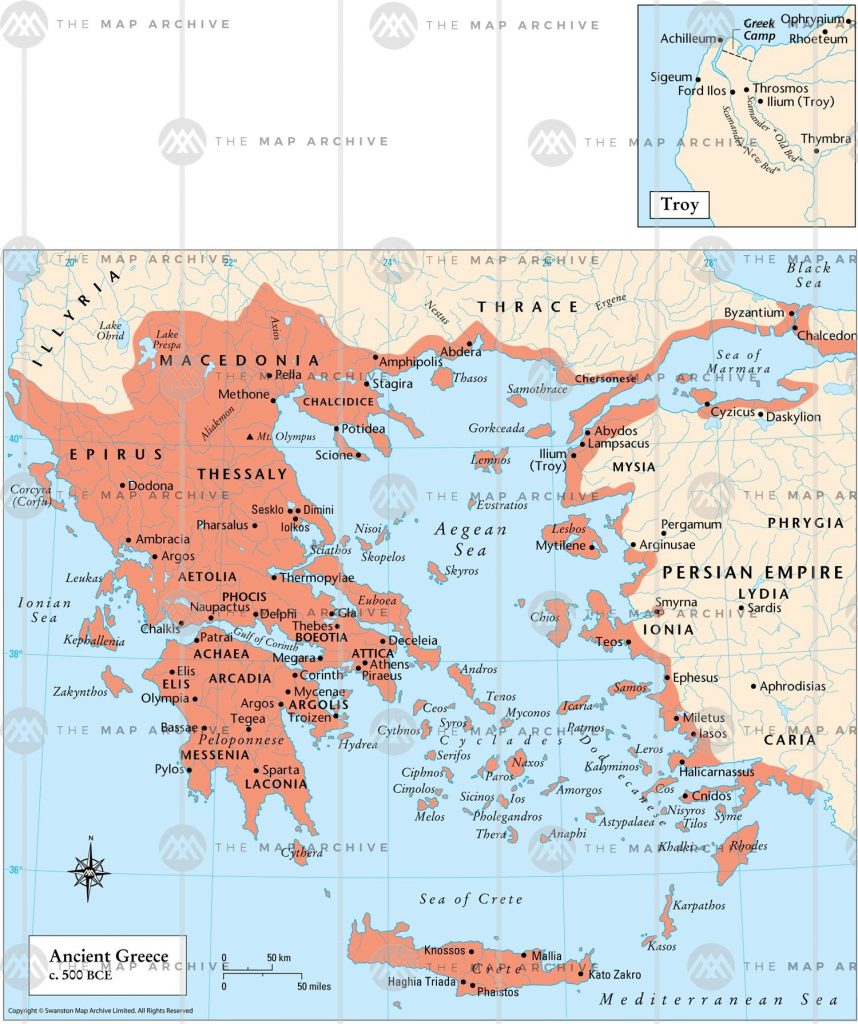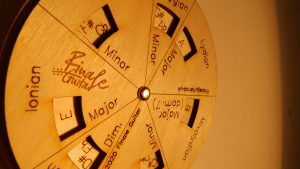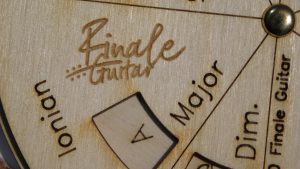

Map of ancient Greece, 500BC
Learn this ultra useful bit of music theory today- the most useful Celtic music lesson (ionian mode, dorian mode, mixolydian mode and aeolian mode)
What follows is a slightly modified section taken from my book, Backing Guitar Techniques for Traditional Celtic Music. It is available here as an e-book with accompanying audio download or here in paperback.
I have also made two accompanying videos which cover all the material in this blog and delve into how to find the chords to fit with each mode- you can find them at the bottom of this page.
The “Greek” modes
There are seven “Greek modes” (named after regions in ancient Greece and surrounding areas) and it is important to remember their names and orders. These are as follows:
- Ionian mode
- Dorian mode
- Phrygian mode
- Lydian mode
- Mixolydian mode
- Aeolian mode
- Locrian mode
I find it easier to remember their names using this helpful mnemonic:
I Don’t Punch Little Men After Lunch.
Modes for Celtic music
Folk music from the Celtic tradition generally only uses four of them (apart from some modern tunes) so it is on these four that I will focus in this blog, but as I’ve said it will be VERY useful to you to remember the names and orders of all of them.
The four Celtic modes are:
- Ionian – standard major scale
- Dorian – “optimistic” minor scale
- Mixolydian – major scale with a flatted 7th note (think blues)
- Aeolian – “pessimistic” minor scale
It is important to practice listening for the differences between modes. If you buy my e-book, Backing Guitar Techniques For Traditional Celtic Music, you can hear play-throughs of each mode in the accompanying audio. Developing your ear is the most important thing you can do as a backing guitarist.
Characteristics of different modes
To help with the identification of modes it is useful to identify the characteristic sound of each one. To this end I have described in the following table the way that each mode differs from a major scale and also (far more importantly) how I would describe their characters. In order to keep the strain on your memory to a minimum I have only included the ones which are relevant to the traditional music of the Celtic nations.
The numbers in the “differences” box refer to the degrees of the scale. “b3” for example means that the 3rd note of the scale is flattened by a semitone. To continue the example, this means that a D mixolydian scale would contain the notes D, E, F#, G, A, B, C, aka all the notes of a D major scale but with the seventh, C#, flattened by a semitone, making it C.
| Name of mode | Degree | Difference from major scale | Sound/ character |
|---|---|---|---|
| Ionian | I | None | Standard happy scale, do ray mi fah etc |
| Dorian | II | b3, b7 | Optimistic minor – to me it has the air of a jubilant post-battle scene from a film about knights. Much more common than aeolian. |
| Mixolydian | V | b7 | Blues-y. Generally happy but with a haunting, mystical quality from the flattened 7th. My favourite folk mode. |
| Aeolian | VI | b3, b6, b7 | Pessimistic minor (classically trained musicians will know this as the natural minor scale). Only differs from dorian by the 6th note which is a semitone lower in aeolian, taking away the optimism. Sounds like oil slicks, forest fires and death. |
It never ceases to amaze me how many backing guitarists cannot hear which mode is being played – please don’t be like them. Practice memorising the characteristic sound of each mode as much as you can.
Relativity of modes
Remember I said it would be useful to remember the names and order of all the modes? Well here’s why. The C ionian (aka C major) scale is all the white notes on a piano, aka C, D, E, F, G, A, B and back to C. If you don’t know why the scale contains those particular notes then you can find out in my previous blog available here.
If you play those same notes but starting and ending on the 2nd degree of the scale, aka D, you will have just played a D dorian scale, D, E, F, G, A, B, C, D. D dorian is a minor sounding scale (with a more optimistic quality than aeolian due to the 6th note in aeolian being flattened) starting and finishing on D. Your ears infer from the starting and finishing note that the scale being played is a minor scale based on D rather than a major scale based on C. They infer the mode of tunes by listening for which notes are most prevalent on dominant beats of the melody and which note the tune finished on.
The same notes but starting and ending on the third degree of the scale would be E, F, G, A, B, C, D and E, otherwise known as E phrygian. The same procedure for the fourth degree would give us F, G, A, B, C, D and E. That one is F lydian. For the fifth you would get G mixolydian, for the sixth A aeolian and for the seventh F# locrian.
The point is that the modes are all related meaning that if you remember their order, you can work out what notes they contain easily. Knowing this will help you work out their key signatures, a useful bit of knowledge when learning to pick the right chords.
The related nature of modes can also be used to work out all the possible chords available in a given mode, because the chord scale is also related. Again, if you don’t know what I mean by “the chord scale”, then please review my previous blog which will show you why certain chords work together in a major key.
Here’s an example:
Humours of Ballyloughlin is a jig in D mixolydian (recording included in the audio folder which comes free with my e-book). Mixolydian is the 5th of the Greek modes. If D is the 5th note, the 1st is G (count back through the alphabet). Therefore it contains the same notes as a G ionian (major) scale, aka G, A, B, C, D, E, F# and G. However, in order to make it D mixolydian you start and finish on D instead, so the scale would be D, E, F#, G, A, B, C and D.
Therefore the chords that you can use under Humours of Ballyloughlin are the same ones which would be available for a tune in G major but with the root changed to the 5th degree of a G major scale, which is D;
| G major chords: | ||||||
|---|---|---|---|---|---|---|
| I | II | III | IV | V | VI | VII |
| Major | Minor | Minor | Major | Major | Minor | Minor b5 |
| G major | A minor | B minor | C major | D major | E minor | F# dim. |
| D mixolydian chords: | ||||||
|---|---|---|---|---|---|---|
| I | II | III | IV | V | VI | VII |
| Major | Minor | Minor b5 | Major | Minor | Minor | Major |
| D major | E minor | F# dim. | G major | A minor | B minor | C major |
This is true for all the modes, so related to G ionian, the same chords would be available in A dorian, B phrygian, C lydian, D mixolydian, E aeolian and F# locrian.
D ionian would contain the same notes and chords as E dorian, F# phrygian, G lydian, A mixolydian, B aeolian and C# locrian.
Why the sharps? Because they come from the major scale. A D major scale has F# and C# in it. Thus the third chord in the key of D major will be an F# based chord. This holds true for any other modes which contain the same notes, so E dorian also contains F# and C#, as do F# phrygian, G lydian etc. This is why it’s useful to memorise the key signatures.
Common “folk keys”
For folk purposes you only need remember the “folk keys”. Here’s a table of the common ones, which also shows which contain the same chords. It is probably wise to make your own differently formatted version of the table below in order to help you remember them (even better if you work them all out yourself and then double check against this table).
| Chords available | Ionian (I) | Dorian (II) | Mixolydian (V) | Aeolian (VI) |
|---|---|---|---|---|
| C, Dm, Em, F, G,Am, B dim | C ionian | D dorian | G mixolydian | A aeolian |
| G, Am, Bm, C, D,Em, F# dim | G ionian | A dorian | D mixolydian | E aeolian |
| D, Em, F#m, G, A,Bm, C# dim | D ionian | E dorian | A mixolydian | B aeolian |
| A, Bm, C#m, D, E, F#m, G# dim | A ionian | B dorian | E mixolydian | F# aeolian |
The Amazing Mode Wheel

Quite possibly the most useful device ever
If you’re a bit confused by all of the above, or would like a quick and easy way to memories it all there is an easy way to fully understand and apply modal theory to your Celtic backing guitar. A much easier way to learn which chords go together is to use my invention the Amazing Mode Wheel. This device is super useful for about a million reasons. It has far too many applications to fully enumerate here, but here are a few of the things that it can do:
- Show you which sharps or flats are in any key or mode
- Tell you all seven chords which will fit with a tune in any given mode and which will be the main three
- Fit in the front pocket of your guitar case so you can quickly work out all the chords for a tune you haven’t played before (14cm circle)
- Transpose chord progressions from one key/mode to another
- Visually represent modal relationships making them easy to understand
- Help you to quickly memorise key signatures
- Make your friends very jealous (until you tell them where you got it from and they order one too)
 I have been using this device in my lessons for the past few months and it really does make the whole concept a million times easier to understand. Trials with my students have shown that working out which chords will fit with a given tune is made much easier with the help of the Mode Wheel and the visual representation makes the theory much easier to understand, memorise and apply.
I have been using this device in my lessons for the past few months and it really does make the whole concept a million times easier to understand. Trials with my students have shown that working out which chords will fit with a given tune is made much easier with the help of the Mode Wheel and the visual representation makes the theory much easier to understand, memorise and apply.
Buy your Mode Wheel today by clicking here.
Music theory for Celtic music videos
Here are my videos demonstrating how the Greek modes work for Celtic guitarists- part one shows you how to form each of the modal scales and part two shows you how we work out the chords to fit with each one. You can find loads more great folk / Celtic guitar tutorials on my channel Folk Friend.


5 Comments
This was really interesting, gave me a lot to ponder. Thanks
No problem Brian, glad it was helpful! Keep an eye on my Youtube channels (Folk Friend and Finale Guitar) and sign up to the mailing list for more free tips.
Thanks 🙂
Maintain the excellent work and bringing in the group!
Keep up the outstanding job !! Lovin’ it!
You’ve gotten the most effective webpages.